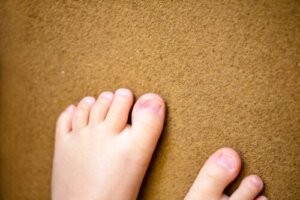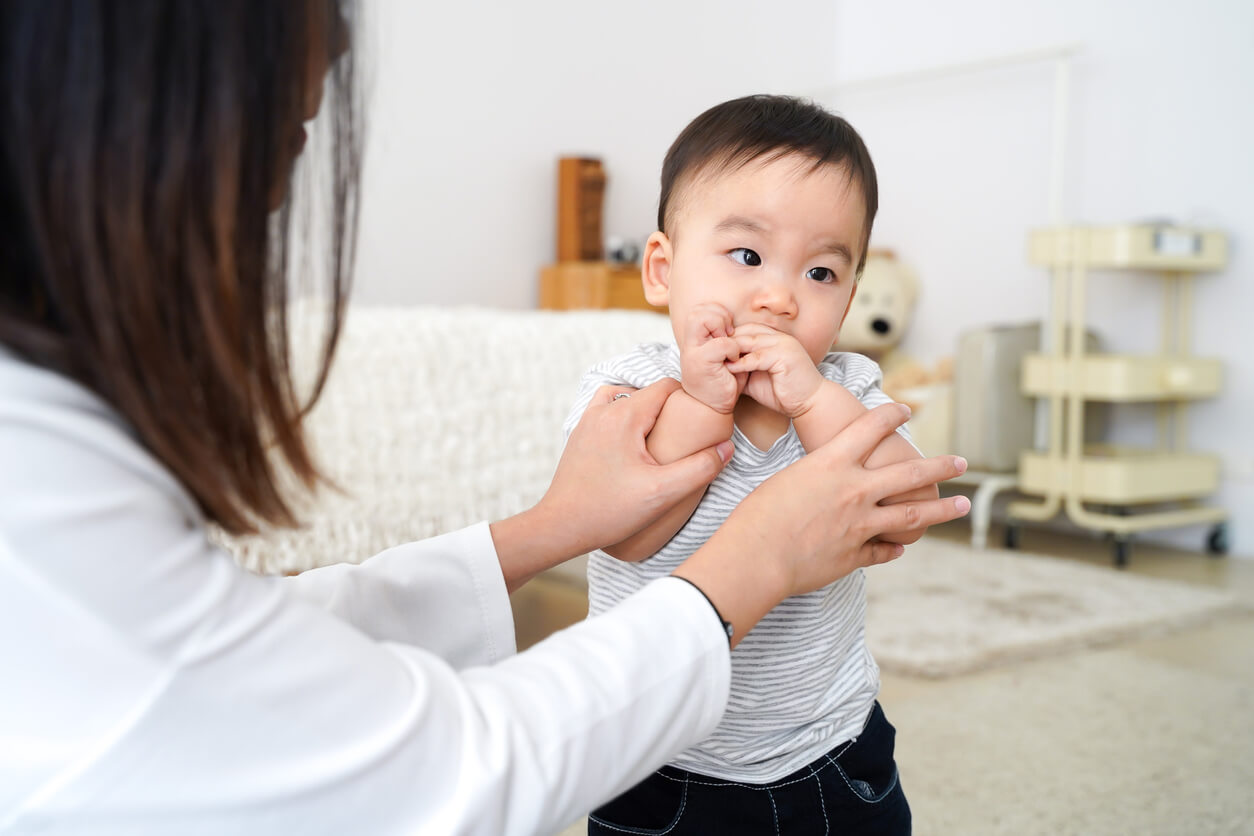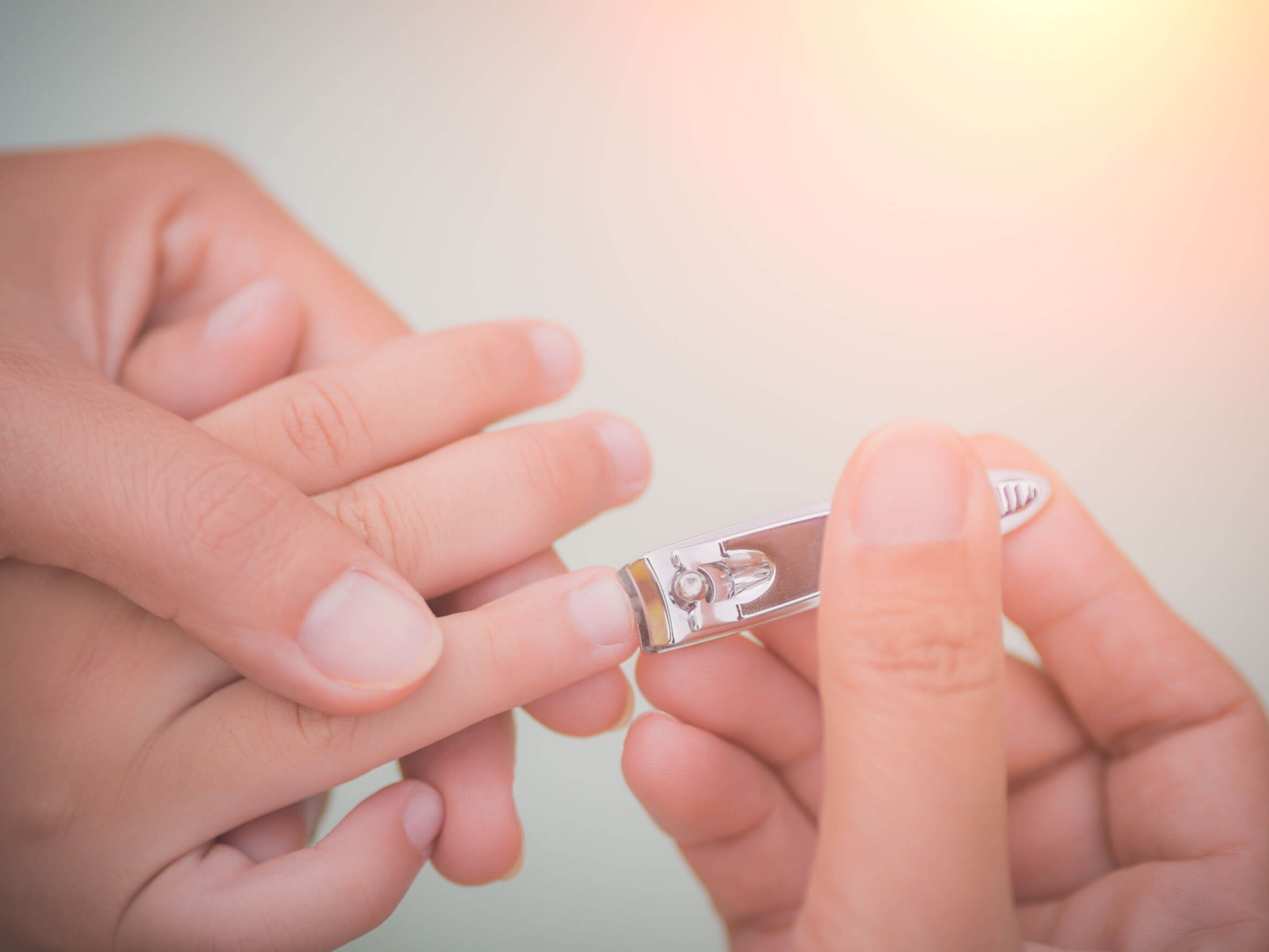Paronychia in Babies and Children: How to Treat It


Written and verified by the dermatologist Maria del Carmen Hernandez
Paronychia in babies and children is an inflammatory disorder of the nail folds of both fingers and toes, which appear in the form of redness, tenderness, and swelling. Its scientific name is paronychia.
Although it occurs more frequently in adults, it’s also common in children and infants. Therefore, it’s important to know how to manage these infections.
What causes paronychia in infants and children?
The oral trauma caused by sucking the fingers predisposes infants and children to develop infections by germs that are very different from those of adults. Contamination of the lesion with saliva can lead to a variety of conditions and even to the generation of abscesses within the nail fold.
According to a study published in the American Journal of Surgery, in the pediatric population, paronychia is caused by mixed anaerobic and aerobic bacteria in 46% of cases. And these usually originate from the oral cavity.

Therefore, babies with finger-sucking behaviors to calm down may have a higher risk of developing nail beds.
Signs and symptoms of paronychia in babies and children
Paronychia in babies and children isn’t a common condition, however, it’s a reason for medical consultation within the first days due to pain.
In short, paronychia is an inflammatory process characterized by the following local symptomatology:
- Redness
- Swelling
- Increased sensitivity
- Pain
You may be interested in: Home Remedies to Help Stop Nail-Biting in Children
Therapeutic options for paronychia in babies and children
Paronychia usually disappears after a few days. If this isn’t the case, there are different therapeutic options to treat it. In fact, the way it’s managed depends on the severity of the condition, the duration, and the age of the affected person.
Hygienic measures
The initial treatment is warm water and salt baths on the affected fingers. In some cases, the use of antiseptic solutions (povidone iodine or chlorhexidine) or 1% Burow’s solution is also recommended.
Continuous brine baths help to reduce inflammation and pain in the affected area. It’s best to practice them several times a day, for at least 10 to 15 minutes. In general, they’re usually quite effective.
In turn, it’s not a good idea to cut the nails in a rounded shape, nor to trim the cuticles or the skin. In fact, poor nail trimming is one of the most frequent causes of paronychia.
Oral antibiotic treatment
Oral medication treatment accompanies hygienic measures. Antibiotics that cover common skin germs (such as cephalexin) or broaden the spectrum for bacteria from the child’s mouth (such as trimethoprim-sulfamethoxazole) are recommended.
In most cases, oral antibiotics should be prescribed for 7 to 10 days. Follow your health care provider’s instructions and don’t stop taking the medication even if your child reports feeling better.
Read also: How to Treat Ingrown Toenails
Topical medications
If brine baths fail to control inflammation, topical corticosteroids may be necessary. These help to soothe the pain and reduce inflammation. Several topical antibiotics (such as mupirocin, fusidic acid, and bacitracin) even include them in their presentation as triple antibiotic ointments.
The idea is to apply the antibiotic cream 4 to 5 times a day on the affected areas, on freshly moisturized skin. There are different presentations such as the following:
- Ointment
- Cream
- Lotion
- Gel
Ointments tend to remain for longer periods on the area to be treated compared to creams.
Surgical treatment
Although the initial therapy is hygienic measures and topical or oral medications, incision and drainage in the area is a useful adjunct to healing.

This procedure is reserved for abscesses, in which it’s pertinent to evacuate the pus and relieve the pressure of inflammation in the affected area. It’s performed with a scalpel and local anesthesia and doesn’t necessarily require hospitalization.
In addition, treatment includes trimming and removal of the ingrown spicule to allow normal nail growth.
Differential diagnosis of paronychia
The differential diagnosis of paronychia can include different skin and soft tissue diseases. Some of them are the following:
- Cellulitis: a superficial infection that presents with redness and swelling, but without tissue fluctuation due to the presence of pus or fluids.
- Herpetic whitlow: is a viral infection of the finger caused by the herpes simplex virus (HSV).
- Onychomycosis is a fungal infection that causes yellowish-whitish discoloration.
- Nail psoriasis: thickened nails, with pitting areas, ridges, and irregular contours.
- Squamous cell carcinoma: in most cases, it occurs in the skin, but also occurs in the nail bed.
Paronychia in babies and children
Paronychia in babies and children usually has a good prognosis, and in most cases, resolves within a few days.
There are countless home remedies that are shared on social networks, but self-medication in children isn’t recommended, even in cases of paronychia. If in doubt, contact your doctor.
Paronychia in babies and children is an inflammatory disorder of the nail folds of both fingers and toes, which appear in the form of redness, tenderness, and swelling. Its scientific name is paronychia.
Although it occurs more frequently in adults, it’s also common in children and infants. Therefore, it’s important to know how to manage these infections.
What causes paronychia in infants and children?
The oral trauma caused by sucking the fingers predisposes infants and children to develop infections by germs that are very different from those of adults. Contamination of the lesion with saliva can lead to a variety of conditions and even to the generation of abscesses within the nail fold.
According to a study published in the American Journal of Surgery, in the pediatric population, paronychia is caused by mixed anaerobic and aerobic bacteria in 46% of cases. And these usually originate from the oral cavity.

Therefore, babies with finger-sucking behaviors to calm down may have a higher risk of developing nail beds.
Signs and symptoms of paronychia in babies and children
Paronychia in babies and children isn’t a common condition, however, it’s a reason for medical consultation within the first days due to pain.
In short, paronychia is an inflammatory process characterized by the following local symptomatology:
- Redness
- Swelling
- Increased sensitivity
- Pain
You may be interested in: Home Remedies to Help Stop Nail-Biting in Children
Therapeutic options for paronychia in babies and children
Paronychia usually disappears after a few days. If this isn’t the case, there are different therapeutic options to treat it. In fact, the way it’s managed depends on the severity of the condition, the duration, and the age of the affected person.
Hygienic measures
The initial treatment is warm water and salt baths on the affected fingers. In some cases, the use of antiseptic solutions (povidone iodine or chlorhexidine) or 1% Burow’s solution is also recommended.
Continuous brine baths help to reduce inflammation and pain in the affected area. It’s best to practice them several times a day, for at least 10 to 15 minutes. In general, they’re usually quite effective.
In turn, it’s not a good idea to cut the nails in a rounded shape, nor to trim the cuticles or the skin. In fact, poor nail trimming is one of the most frequent causes of paronychia.
Oral antibiotic treatment
Oral medication treatment accompanies hygienic measures. Antibiotics that cover common skin germs (such as cephalexin) or broaden the spectrum for bacteria from the child’s mouth (such as trimethoprim-sulfamethoxazole) are recommended.
In most cases, oral antibiotics should be prescribed for 7 to 10 days. Follow your health care provider’s instructions and don’t stop taking the medication even if your child reports feeling better.
Read also: How to Treat Ingrown Toenails
Topical medications
If brine baths fail to control inflammation, topical corticosteroids may be necessary. These help to soothe the pain and reduce inflammation. Several topical antibiotics (such as mupirocin, fusidic acid, and bacitracin) even include them in their presentation as triple antibiotic ointments.
The idea is to apply the antibiotic cream 4 to 5 times a day on the affected areas, on freshly moisturized skin. There are different presentations such as the following:
- Ointment
- Cream
- Lotion
- Gel
Ointments tend to remain for longer periods on the area to be treated compared to creams.
Surgical treatment
Although the initial therapy is hygienic measures and topical or oral medications, incision and drainage in the area is a useful adjunct to healing.

This procedure is reserved for abscesses, in which it’s pertinent to evacuate the pus and relieve the pressure of inflammation in the affected area. It’s performed with a scalpel and local anesthesia and doesn’t necessarily require hospitalization.
In addition, treatment includes trimming and removal of the ingrown spicule to allow normal nail growth.
Differential diagnosis of paronychia
The differential diagnosis of paronychia can include different skin and soft tissue diseases. Some of them are the following:
- Cellulitis: a superficial infection that presents with redness and swelling, but without tissue fluctuation due to the presence of pus or fluids.
- Herpetic whitlow: is a viral infection of the finger caused by the herpes simplex virus (HSV).
- Onychomycosis is a fungal infection that causes yellowish-whitish discoloration.
- Nail psoriasis: thickened nails, with pitting areas, ridges, and irregular contours.
- Squamous cell carcinoma: in most cases, it occurs in the skin, but also occurs in the nail bed.
Paronychia in babies and children
Paronychia in babies and children usually has a good prognosis, and in most cases, resolves within a few days.
There are countless home remedies that are shared on social networks, but self-medication in children isn’t recommended, even in cases of paronychia. If in doubt, contact your doctor.
All cited sources were thoroughly reviewed by our team to ensure their quality, reliability, currency, and validity. The bibliography of this article was considered reliable and of academic or scientific accuracy.
- Brook I. (1981) Bacteriologic study of paronychia in children. Am J Surg;141(6):703-5. doi: 10.1016/0002-9610(81)90082-9. PMID: 6972709.
- Ritting AW, O’Malley MP, Rodner CM. (2012) Acute paronychia. J Hand Surg Am;37(5):1068-70; quiz page 1070. doi: 10.1016/j.jhsa.2011.11.021. Epub 2012 Feb 3. PMID: 22305431.
- Lomax A, Thornton J, Singh D. (2016) Toenail paronychia. Foot Ankle Surg;22(4):219-223. doi: 10.1016/j.fas.2015.09.003. Epub 2015 Sep 21. PMID: 27810017.
- Shafritz AB, Coppage JM. (2014) Acute and chronic paronychia of the hand. J Am Acad Orthop Surg;22(3):165-74. doi: 10.5435/JAAOS-22-03-165. PMID: 24603826.
- Leggit JC. (2017) Acute and Chronic Paronychia. Am Fam Physician 1;96(1):44-51. PMID: 28671378.
- Lorenzo Ramírez, M.D., Navarro Torres, M., Cases Jordán, C., et al. (2021). Propiedades del agua de burow. Revista sanitaria de investigación. [Internet] Recuperado el 12-04-2022 de: https://revistasanitariadeinvestigacion.com/propiedades-del-agua-de-burow/.
- Comité de Medicamentos de la Asociación Española de Pediatría (2020). Cefalexina. Pediamecum. Disponible en: https://www.aeped.es/comite-medicamentos/pediamecum/cefalexina.
- Barreiro L, et al. Psoriasis ungueal. Anales de Pediatría 2014;81(6):e14-e15. Disponible en: https://www.analesdepediatria.org/es-psoriasis-ungueal-articulo-S169540331300489X.
- Gutiérrez-Gómez C, Gargollo-Orvañanos C, Javier LF, et al. Soy herpes no me operes por favor. Cir Plast. 2020;30(2):117-122. doi:10.35366/97675.
This text is provided for informational purposes only and does not replace consultation with a professional. If in doubt, consult your specialist.








